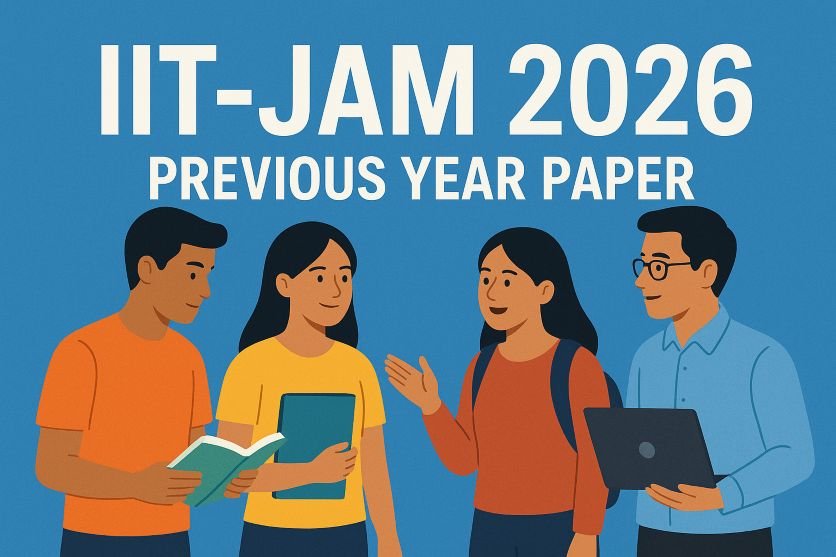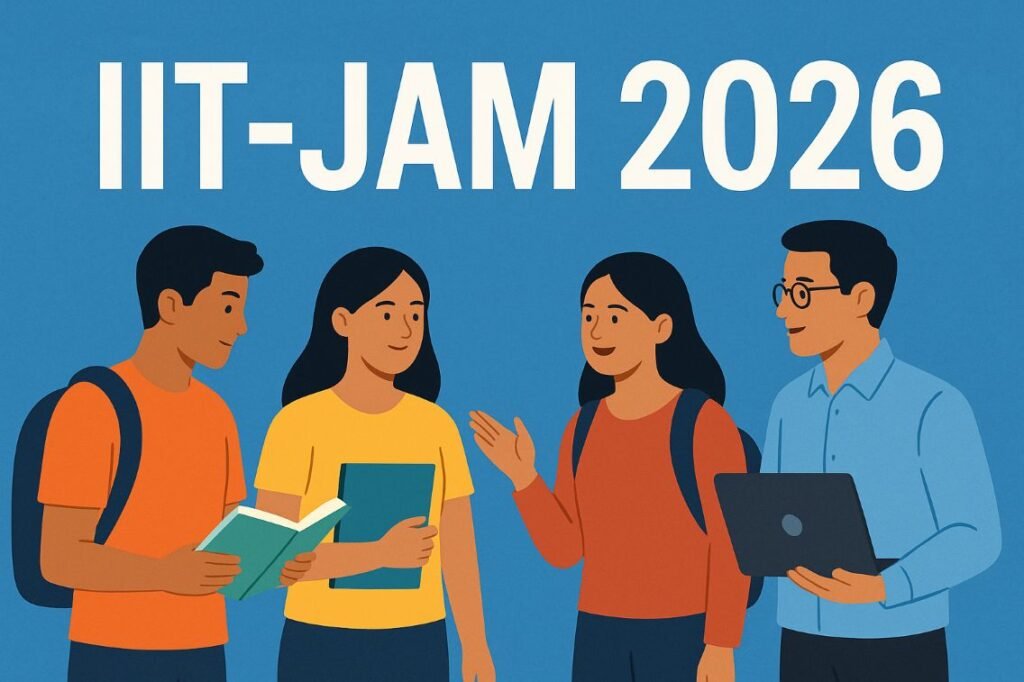IIT JAM 2026: Your Ultimate Guide to Cracking the Exam for Top Science PG Admissions
In the competitive world of postgraduate science education in India, the IIT JAM 2026 stands as a golden gateway for aspiring students. Organized by the prestigious Indian Institute of Technology Bombay (IIT Bombay), this national-level entrance exam opens doors to elite MSc, Joint MSc-PhD, and other integrated programs across 22 IITs and other top institutes like NITs and CFTIs. If you’re a science graduate eyeing advanced studies in fields like Physics, Chemistry, or Biotechnology, understanding IIT JAM 2026 eligibility, exam dates, and preparation strategies is crucial.
With over 50,000 candidates appearing annually, securing a rank under 1000 can land you in your dream IIT. This comprehensive guide breaks down everything from IIT JAM 2026 syllabus PDF downloads to smart preparation tips for IIT JAM 2026, helping you navigate the process with confidence. Whether you’re a final-year undergrad or a working professional, how to apply for IIT JAM 2026 starts with early planning. Dive in to unlock success!
What is IIT JAM 2026? A Quick Overview
The Joint Admission Test for Masters (JAM) is a computer-based test (CBT) conducted annually by one of the IITs on a rotational basis. For IIT JAM 2026, IIT Bombay takes the helm, making it a pivotal event for science enthusiasts. It assesses candidates’ knowledge in seven core subjects, facilitating admissions to over 3,000 seats in postgraduate programs. Unlike GATE, JAM focuses purely on science streams, emphasizing conceptual depth over rote learning. The exam not only tests academic prowess but also prepares you for research-oriented careers. With a legacy since 2004, IIT JAM 2026 registration has already kicked off, signaling high stakes for aspirants aiming for scholarships worth up to INR 12,400 monthly.
IIT JAM 2026 Eligibility Criteria: Who Can Apply?
Meeting the IIT JAM 2026 eligibility is the first step toward your application. Broadly, candidates need a bachelor’s degree, but specifics vary by category and program. No age limit applies, making it accessible for all. Here’s a detailed breakdown:
Key Eligibility Points:
- Educational Qualification: A Bachelor’s degree (3 or 4 years) from a recognized university or institute. Final-year students can apply provisionally, provided they submit proof of passing by enrollment time.
- Minimum Marks:
- General/OBC-NCL/EWS: At least 55% aggregate or equivalent CGPA.
- SC/ST/PwD: At least 50% aggregate or equivalent CGPA.
- Nationality: Indian nationals, including OCI/PIO, are eligible. Foreign nationals follow institute-specific rules.
- Additional Notes: Candidates with a 4-year BS/BS (Hons) degree or equivalent need to check Minimum Educational Qualifications (MEQs) per program. No attempt limit exists, but only the latest score counts.

| Category | Minimum Aggregate Marks/CGPA | Remarks |
|---|---|---|
| General/OBC-NCL/EWS | 55% or 5.5/10 CGPA | Applies to all subjects |
| SC/ST/PwD | 50% or 5.0/10 CGPA | Relaxation for reserved categories |
| Final-Year Students | Provisional Eligibility | Degree completion proof required by June 2026 |
This criteria ensures a level playing field, with relaxations promoting inclusivity. Always verify on the official site for updates.
IIT JAM 2026 Important Dates: Mark Your Calendar
Timing is everything in exam prep. The IIT JAM 2026 exam date is set for February 15, 2026, giving you ample time from now (September 2025) to gear up. All dates are tentative and subject to official confirmation.
| Event | Date |
|---|---|
| JAM Online Application Processing System (JOAPS) Website Opens | September 05, 2025 |
| Last Date for Closing Registration | October 12, 2025 |
| Availability of JAM Admit Cards (Download) | January 05, 2026 |
| Date of Examination | February 15, 2026 |
| Announcement of Results | March 20, 2026 |
| Admission Process Starts (Counseling) | April 2026 (Tentative) |
Pro Tip: Download your admit card early to avoid last-minute glitches. Missing the IIT JAM 2026 registration deadline means waiting another year!
Subjects Offered in IIT JAM 2026 and Seat Matrix
IIT JAM 2026 subjects include seven test papers, each leading to specialized PG programs. You can opt for one or two papers, but admissions are based on your best score. Total seats exceed 3,000 across IITs, with a focus on diversity.
List of Subjects:
- Biotechnology (BT)
- Chemistry (CY)
- Economics (EN)
- Geology (GG)
- Mathematics (MA)
- Mathematical Statistics (MS)
- Physics (PH)
Subject-Wise Seat Matrix (Approximate for 2026, Based on Trends):
| Subject | Total Seats (Approx.) | Key Institutes | Programs Offered |
|---|---|---|---|
| Biotechnology (BT) | 450 | IIT Bombay, IIT Delhi, IIT Roorkee | MSc Biotechnology, MSc-MTech Dual |
| Chemistry (CY) | 500 | IIT Madras, IIT Kharagpur, IISc Bangalore | MSc Chemistry, Joint MSc-PhD |
| Economics (EN) | 200 | IIT Delhi, IIT Kanpur | MSc Economics |
| Geology (GG) | 150 | IIT Bombay, IIT Roorkee | MSc Applied Geology |
| Mathematics (MA) | 600 | IIT Bombay, IIT Madras | MSc Mathematics |
| Mathematical Statistics (MS) | 100 | IIT Bombay | MSc Mathematical Statistics |
| Physics (PH) | 700 | IIT Delhi, IIT Kanpur, IISERs | MSc Physics, Integrated PhD |
These numbers include reservations (27% OBC, 15% SC, 7.5% ST, 10% EWS, 5% PwD). Check the brochure for exact MEQs per program. Geology and Economics often have lower competition, ideal for strategic choices.

How to Apply for IIT JAM 2026: Step-by-Step Process
The IIT JAM 2026 application process is fully online via the JOAPS portal at jam2026.iitb.ac.in. Fee: INR 900 (one paper, General/OBC) to INR 225 (SC/ST/PwD, one paper). Pay via net banking/credit/debit card.
Application Steps:
- Register on JOAPS: Visit the portal, create an account with email and password. Verify via OTP.
- Fill Personal Details: Enter name, DOB, category, nationality, and contact info. Upload photo (3.5×4.5 cm, <100KB) and signature (<50KB, black ink on white paper).
- Select Test Paper(s): Choose up to two subjects. You can change later before deadline.
- Enter Academic Details: Input qualifying degree marks, board/university info.
- Upload Documents: Certificates for category (OBC-NCL/EWS/SC/ST/PwD, valid as of Oct 12, 2025) and DOB proof (Class X certificate).
- Pay Application Fee: Online payment; female/SC/ST/PwD get concessions.
- Submit and Print: Review form, submit, and download confirmation. Corrections allowed till Oct 12.
Corrections window: Oct 13-15, 2025 (limited fields). Track status on portal.
IIT JAM 2026 Exam Pattern: Understand the Format
The IIT JAM 2026 exam pattern is designed to test speed and accuracy in a 3-hour CBT. Total: 60 questions, 100 marks, English medium. No sectional timing, but all compulsory.
| Section | Question Type | No. of Questions | Marks per Question | Total Marks | Negative Marking |
|---|---|---|---|---|---|
| A | Multiple Choice Questions (MCQ) | 30 | 1 or 2 | 30 (10×1 + 20×2) | Yes (-1/3 for 1-mark, -2/3 for 2-mark) |
| B | Multiple Select Questions (MSQ) | 10 | 2 | 20 | No |
| C | Numerical Answer Type (NAT) | 20 | 1 or 2 | 50 (10×1 + 10×2) | No |
- MCQ: Single correct option; four choices.
- MSQ: One or more correct; partial marking.
- NAT: Enter numeric value (0-9 digits, decimal allowed); no options.
Practice mocks to master NATs. Total attempts: All questions; aim for 70%+ for top ranks.
IIT JAM 2026 Syllabus: Subject-Wise Breakdown
The IIT JAM 2026 syllabus mirrors undergraduate curricula, emphasizing fundamentals. Download PDFs from jam2026.iitb.ac.in. Below is a detailed overview—focus on high-weightage topics like calculus in Math or mechanics in Physics.
Biotechnology (BT):
- Biology: Cell biology, genetics, microbiology, biochemistry, molecular biology, plant/animal physiology.
- Chemistry: Basic organic, inorganic, physical chemistry.
- Mathematics/Physics: Sequences, differential equations, electrostatics, thermodynamics.
- Biotechnology-Specific: Recombinant DNA, immunology, bioinformatics.
Chemistry (CY):
- Physical Chemistry: Atomic structure, thermodynamics, kinetics, electrochemistry, quantum chemistry.
- Organic Chemistry: Reaction mechanisms, stereochemistry, named reactions, spectroscopy.
- Inorganic Chemistry: Periodic table, coordination compounds, organometallics, bioinorganic.
Economics (EN):
- Microeconomics: Consumer theory, market structures, game theory.
- Macroeconomics: National income, inflation, growth models.
- Statistics/Mathematics: Probability, linear algebra, optimization.
- Indian Economy: Reforms, planning.
Geology (GG):
- Geomorphology: Landforms, weathering, plate tectonics.
- Structural Geology: Folds, faults, stress-strain.
- Paleontology: Fossils, evolution.
- Stratigraphy/Mineralogy: Rock systems, crystal structures, economic geology.
- Petrology: Igneous, sedimentary, metamorphic rocks.
Mathematics (MA):
- Real Analysis: Sequences, continuity, Riemann integration.
- Multivariable Calculus: Limits, Jacobians, Stokes’ theorem.
- Linear Algebra: Matrices, eigenvalues, vector spaces.
- Differential Equations: ODEs, PDEs.
- Modern Algebra: Groups, rings, fields.
Mathematical Statistics (MS):
- Probability: Distributions, expectation, limit theorems.
- Statistical Inference: Estimation, hypothesis testing.
- Linear Models: Regression, ANOVA.
- Multivariate Analysis: Sampling, principal components.
Physics (PH):
- Mechanics: Newton’s laws, Lagrangian, central forces.
- Electromagnetism: Electrostatics, Maxwell’s equations.
- Optics/Thermodynamics: Wave optics, laws of thermo, kinetic theory.
- Modern Physics: Relativity, quantum mechanics, atomic spectra.
- Mathematical Methods: Vectors, differential equations, Fourier series.
Prioritize 60-70% syllabus coverage for a strong base. Use standard texts like HC Verma for Physics or JD Lee for Chemistry.
Preparation Tips for IIT JAM 2026: Ace It Like a Pro
Cracking IIT JAM 2026 preparation tips involve disciplined strategy. With 5 months left, here’s how to optimize:
- Build a Study Plan: Dedicate 6-8 hours daily; cover syllabus in 3 months, revise in 1, mocks in last month. Use Pomodoro for focus.
- Resources: Stick to NCERT + standard books (e.g., OP Tandon for Chemistry). Join online courses like IFAS or PW for video lectures.
- Practice Rigorously: Solve 10+ previous papers; analyze errors. Weekly mocks to simulate exam pressure.
- Focus on Weak Areas: Track progress via topic-wise tests. For NATs, hone calculation speed without calculators.
- Health & Mindset: Sleep 7 hours, exercise; join study groups for motivation. Avoid burnout—balance with breaks.
- Common Pitfalls: Don’t ignore MSQs; practice partial marking. Revise formulas daily.
Toppers recommend 70% theory + 30% practice for 90+ percentile.
IIT JAM 2025 Cutoffs: Reference for 2026 Targets
While IIT JAM 2026 cutoffs aren’t out, use 2025 data for benchmarks. Qualifying marks ensure eligibility; ranks decide admissions.
| Subject | General (Marks) | OBC-NCL/EWS | SC/ST/PwD |
|---|---|---|---|
| Biotechnology | 25.7 | 23.1 | 12.8 |
| Chemistry | 22.4 | 20.2 | 11.2 |
| Economics | 18.5 | 16.7 | 9.2 |
| Geology | 28.9 | 26.0 | 14.4 |
| Mathematics | 19.9 | 17.9 | 9.9 |
| Mathematical Statistics | 8.8 | 7.9 | 4.4 |
| Physics | 24.7 | 22.2 | 12.3 |
Aim 10-15 marks above for safe ranks under 500.
Benefits of Qualifying IIT JAM 2026
- Premier Education: Access world-class faculty and labs at IITs.
- Career Boost: Placements in research, academia, PSUs; average salary INR 10-15 LPA.
- Scholarships: INR 12,400/month + contingency grants.
- Research Opportunities: Direct PhD pathways with fellowships.
- Global Exposure: Ties with international unis for exchanges.
Conclusion: Gear Up for IIT JAM 2026 Success
IIT JAM 2026 isn’t just an exam—it’s your launchpad to scientific excellence. From eligibility checks to mastering the syllabus and acing mocks, consistent effort pays off. Start today: register, plan, and persist. With the right strategy, your IIT dream is within reach. Stay updated via official channels and crush it!

